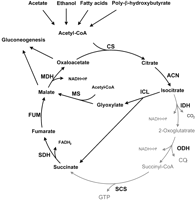Check out this article.
Lohman, Jeremy R., Andrew C. Olson, and S. J. Remington. "Atomic resolution structures of Escherichia coli and Bacillus anthracis malate synthase A: Comparison with isoform G and implications for structure-based drug discovery." Protein Sci. 17.11 Nov. (2008): 1935-45.
Notes on Structure and Reaction Pathway:
This will tell you all you want to know about my structure if you so desire, but I want to focus on some other topics. The article tells how I am important in the virulence of many bacteria and fungi including Mycobacterium tuberculosis and Candida albicans. As a part of the glyoxylate shunt, I help avoid the portion of the TCA cycle which gives off carbon dioxide by taking isocitrate directly to malate. My part of the pathway is the reaction
acetyl-CoA + H2O + glyoxylate <=> (S)-malate + CoA
The benefit to you people is that you don't have my wondrous enzyme, so even though you are missing out on the benefits you can make drugs to inhibit me so those fungi and bacteria can't enjoy the benefits either. Taking away my biosynthetic advantages would seriously hamper their virulence, but I think its just jealousy!
One hint to get you started, my A isoform is regulated by acetate and fatty acids while my G isoform is inhibited by glyoxylate, so you may want to start working on their analogs. Finally, to end on a structural note, my active site is contained within a α8/β8 (TIM) barrel.
More on Virulence and Pathway:
Here is another article which gives more details on the virulent benefits and glyoxylate bypass shunt.
Dunn, M. F., J. A. Ramírez-Trujillo, and I. Hernández-Lucas. "Major roles of isocitrate lyase and malate synthase in bacterial and fungal pathogenesis." Microbiology 155 (2009): 3166-75.
They also go into more detail about the pathway and include some information on how I effect virulence. According to these researchers, my presence as part of the glyoxylate shunt allows bacteria, fungi, and plants to use two carbon compounds like acetyl-CoA to synthesize four carbon dicarboxylic acids which can then be used for gluconeogenesis or other biosynthetic pathways. This is essential for survival in the host organisms. It also allows TCA cycle intermediates to be replenished or increased as necessary.
Some other trivia from this article include the following. I, as a part of the glyoxylate pathway, am essential for the growth of plant seedlings since I am part of the pathway which allows stored lipids to be converted to carbohydrates. I also may have functions as an adhesin and biomarker as recent studies into my effect on M. tuberculosis pathogenicity have shown.
One More:
Vanittanakom, Nongnuch, Chester R. Cooper, Jr., Matthew C. Fisher, and Thira Sirisanthana. "Penicillium marneffei Infection and Recent Advances in the Epidemiology and Molecular Biology Aspects." Clinical Microbiology Reviews 19.1 Jan. (2006): 95-110.
This article is about Penicillium marneffei infection, an opportunistic infection in HIV infected patients in Southeast Asia. It is a fungal infection which has the advantage of being able to live as a mycelium at 25°C and as a yeast at 37°C which makes it particularly virulent. It causes fatal systemic mycosis in those it infects. My role in the process is in the yeast phase. Researchers have found that I am up regulated in the first 20 minutes or so of infection suggesting I have a role in infection in the yeast phase.

Good job, Milton.
ReplyDelete